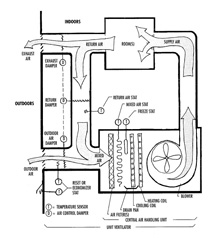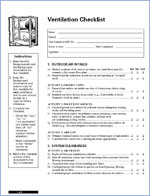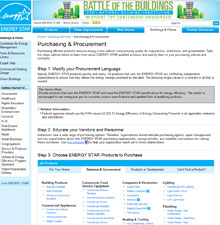Technical Solutions to Common Indoor Air Quality Issues in Schools
On this page:
- Provide Quality HVAC
- Mold and Moisture
- Integrated Pest Management
- Effectively Clean and Maintain
- Make Smart Materials Selections
- Source Control and Chemical Management
On other pages:
Provide Quality HVAC
Quality HVAC system design, operation and maintenance are critical for providing clean and healthy IAQ in schools. Properly functioning HVAC systems provide adequate outdoor ventilation, controlling odors and reducing the pollutants that cause most IAQ problems inside school buildings. In addition to improving occupant health and performance, regular HVAC maintenance saves energy.
Common Solutions to HVAC Issues
I don't know if our school's HVAC system is operating properly or if our air is being contaminated by common pollutants.
- Check with your facilities and maintenance department to discuss the frequency of HVAC system inspection and to create an HVAC maintenance plan.
- For new construction or mechanical systems renovations, consider commissioning, testing and balancing by professionals to be sure the systems are operating as designed and at optimal performance levels.
I want to ensure adequate fresh air circulation at my school.
- Remind school staff and students to keep books, papers and other items off of HVAC units.
- Check with your building operator to ensure outdoor air ventilation is provided according to the American Society of Heating, Refrigerating and Air-Conditioning Engineers (ASHRAE) Standard or local code.
- Ensure that facilities and maintenance staff change filters on a regular basis.
I am concerned that good heating and ventilation practices are incompatible with energy efficiency.
- Implement behavioral and operational changes and develop a method to measure the school's HVAC operations compared to its energy costs.
- Work with your building operator to install efficient fan motors and sizing that match your school district's load.
- Work with your building operator to install an outdoor air measuring station that modulates the outdoor air damper and return damper.
- Consider implementing Demand Control Ventilation (DCV) and installing Variable Frequency Drives (VFDs), which can improve performance and reduce energy costs.
Our school buildings have experienced moisture and mold problems.
- Check with your facilities and maintenance staff to ensure HVAC condensate pans are draining.
- Instruct facilities and maintenance staff to clean all air supply diffusers, return registers and outside air intakes.
- Develop a solid building envelope plan that evaluates the condition of and provides direction for necessary corrective actions for the following elements:
- Roofs;
- Walls;
- Doors; and
- Windows.
School HVAC systems should be designed and operated to provide a minimum outdoor air ventilation rate consistent with current ASHRAE Standards. For classrooms, this standard is about 15 cubic feet per minute (cfm) of outdoor air per person.
For more information:
Mold and Moisture Control
- Conduct routine moisture inspections.
- Establish a mold prevention and remediation plan.
- Maintain indoor humidity levels between 30 and 60 percent.
- Address moisture problems promptly. Dry wet areas within 24 to 48 hours.
- Review EPA's "Mold Remediation in Schools and Large Buildings" to learn about mold growth in schools and how it can be managed.
Read more about controlling moisture and mold.
Integrated Pest Management (IPM)
- Inspect and monitor school environments for pests.
- Establish an IPM plan.
- Use spot treatments and baits rather than broad pesticide applications.
- Communicate with occupants prior to pesticide use.
- Mark indoor and outdoor areas treated with pesticides.
- Use the IPM Checklist from the IAQ Tools for Schools Action Kit.
Visit EPA's Integrated Pest Management (IPM) in Schools site.
Effectively Clean and Maintain
Effective cleaning and maintenance procedures are critical to protecting building systems and building occupants. Student, teacher and staff health and productivity can suffer when school building systems fail to operate as designed. School and district-level cleaning and maintenance programs can be designed to help prevent IAQ problems.
Common Solutions for Cleaning and Maintenance Issues
There have been complaints of illness and discomfort in sensitive individuals due to high dust levels.
- Use vacuums with high-efficiency filters.
- Place barrier floor mats at all building entrances to reduce the amount of dust and dirt that enter the school.
- Remove dust from desks, chairs and other items with a damp cloth.
I want to put proactive cleaning and maintenance practices in place to prevent problems before they begin.
- Conduct routine inspections of indoor school environment.
- Develop a preventative maintenance plan.
- Ensure material safety data sheets (MSDS) are available to staff.
- Understand the benefits of using green products in your school, including cost savings, environmental impact and health impacts to building occupants.
Facilities staff at my school don't use cleaning products in the correct manner.
- Provide regular trainings for facilities and maintenance staff on best practices.
- Institute a systematic approach to every aspect of cleaning a school, including the measurement of product amounts used.
- Create policies and procedures that encourage responsible use of chemicals.
Our school has a large number of grounds supplies, equipment, fertilizer and portable gasoline containers.
- Maintain all cleaning supplies and equipment according to the manufacturers' guidelines.
- Store cleaning supplies and equipment outside of the main school building and in well-ventilated areas.
Our school has a variety of flooring, including vinyl, wood, terrazzo, tile and carpet, which require daily cleaning.
- Follow any specific guidelines from manufacturers or floor suppliers on properly maintaining flooring.
- Perform restorative maintenance as necessary.
We want to ensure that the combustion appliances at our school are functioning properly and safely.
- Visually inspect exhaust components for leaks, disconnections and deterioration.
- Check for backdrafting to ensure that the ventilation system is in normal operating mode.
Make Smart Materials Selections
School environments face threats of exposure to indoor air pollutants due to a variety of factors, including: the construction of more tightly sealed buildings; reduced ventilation rates to save energy; the use of synthetic building materials and furnishings; the increased use of personal care products, pesticides and housekeeping supplies; and the increased use of vehicles and power equipment.
To reduce the impact of indoor air pollutants, choose products that have less of an effect on human health and the environment than equivalent, competing products or services. Look for products that may contain recycled content, or for products and services that minimize waste, conserve energy or water or reduce the amount of toxics disposed or consumed. When building a new school, meet with building planners and design architects to discuss materials selection.
Solutions to Common Materials Selection Issues
I don't know what chemicals or products are currently being used in my school.
- Create and maintain an inventory of all purchased products. Capture information related to chemical storage, emergency response and first aid procedures as well as emergency contact information.
- Only allow products approved by the school or school district in buildings and encourage teachers who wish to keep cleaning chemicals in classrooms to obtain cleaning solutions from the custodial staff, as these chemicals have been approved for district use.
There are no guidelines for purchasing chemicals or other products at our school.
- Select products based on product rating systems, including ENERGY STAR and Design for the Environment.
- Develop policies to only purchase low-emitting products and consider requesting that each area of curriculum designate someone to review purchases.
- When purchasing neutral cleaners, glass cleaners, bathroom cleaners and disinfectants, consider products that have high dilution rates, are designed to reduce waste and have lower end-use costs.
- Consider purchasing building materials that can be easily cleaned and maintained with the same cleaning products used throughout the building.
Sometimes products that are used in our schools make students and staff feel sick or have allergic reactions and/or asthma attacks.
- Use least toxic cleaners possible (only those approved by the district).
- Use low-toxicity and low-emitting paint.
- Use formaldehyde-free materials.
To read more about environmental attributes to look for in products, procurement guidance, tools, case studies and other useful resources:
To learn about the sources and effects of high-emission products visit EPA's:
Source Control and Chemical Management
One of the most effective ways to improve indoor air quality (IAQ) is to eliminate individual sources of pollution, including chemicals or to reduce their emissions. Chemicals may be used by the following throughout a school:
- Students;
- Teachers;
- Facility personnel; and
- Administrative staff.
Consider the possible health, safety and environmental implications before buying a particular chemical. Proper chemical use and management, including storage, labeling and disposal, is critical for reducing chemical exposures and costly accidents.
Common Solutions to Source Control and Chemical Management Issues
There are hazardous chemicals contained on school property that have not been properly addressed.
- Implement a hazardous materials plan detailing chemical use, labeling, storage and disposal using the Schools Chemical Cleanout Campaign as a resource.
- Establish a school chemical management and inventory plan.
- Conduct regular building walk-through inspections; download a PDF or Word version of the Walk-through Inspection Checklist and tailor it to fit the needs of your individual school or district.
I want to minimize student, teacher and administrative staff exposure to hazardous chemicals.
- Conduct pollutant-releasing activities only when the school is unoccupied.
- Use walk-off mats at building entrances.
- Implement comprehensive tobacco-free school policies.
- Establish an anti-idling school bus policy.
I want to ensure our school buildings don't have elevated radon levels.
- Test all school buildings for radon and mitigate if necessary.
- Track radon test results, assessment data and pending actions so that facility maintenance can plan accordingly.
- Retest according to plan if schools were mitigated to ensure radon mitigation systems are functioning properly.
- Schedule re-testing following all major renovations and consider how HVAC modifications or upgrades may affect radon intrusion.
For more information on source control, read about Environmental Contaminants in Schools.



